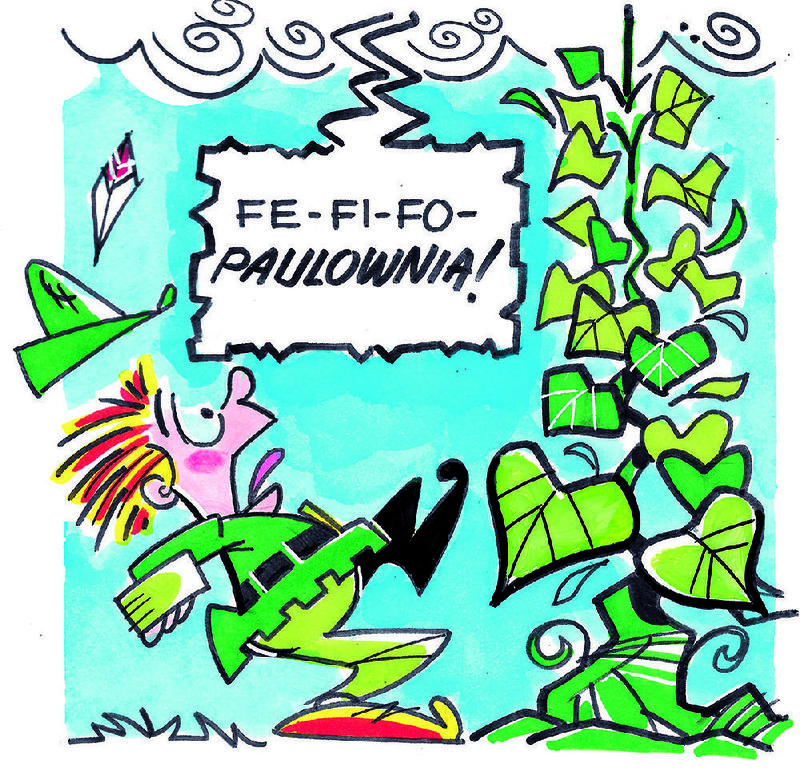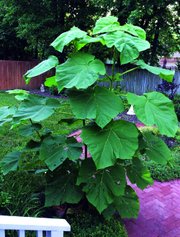Q Do you know what this plant is? It came up "volunteer" last year next to my back steps, and grew 15 feet tall with a single stem. I thought of Jack's beanstalk. It produced no flowers, fruit or seed. It shed leaves in fall and the stem was hard to cut down, being much like wood. This spring it revived with three or more stems. I enjoy watching as wind rustles its leaves and am wondering about it. Local garden experts don't know what it is. Reckon it'll grow tall enough for the ogre to climb down?
A I get more samples of this each year than any other plant. The plant in question will one day be a large tree -- it is Paulownia tomentosa, commonly called Royal Paulownia or empress tree. It is extremely fast growing as a seedling, as you have noticed. It also produces extremely large leaves when young. As it ages, it does slow down a little bit, but then it produces beautiful clusters of purple blooms, which are followed by woody seed capsules that split open and scatter seeds. They germinate readily, and the cycle begins all over again. Their fast growth can also lead to weak wood, which makes the tree less than desirable for a home landscape. Hopefully, no ogres.
Q I saved seeds from a dark crimson crape myrtle that I planted three years ago. I put the seeds in a paper bag and stored them in the crisper drawer over the winter. About a month ago, I put a fistful in a pot and, bingo, a bunch of sprouts now about an inch, inch and a half tall. I need to re-pot a few, but then what? Plant them in the ground soon? Dig them up for overwintering? I intended to sprout them earlier, but I don't use the refrigerator's crisper that much, and so I forgot about them. One more thing -- any idea what variety these could be, and is that variety a hybrid?
A Crape myrtles won't breed true from seed, so the resulting plants may look a lot like their parent, or nothing at all like their parent. You could pot them up in individual pots to give them more room to grow or you could plant them in the ground in a sunny location. In containers they will need more water and more protection in the winter; but either way should work.
Q Two summers ago we had a problem with white flying insects that form a sticky, powdery substance on plants. I mixed up a concoction and sprayed and sprayed and finally seemed to get them under control. This was no small task as we have well over an acre of yard. This summer we are having the same problem ... and they are on every single plant/shrub and even weeds. Do they actually do harm? I am overwhelmed by the prospect of having to spray everything in our yard.
A There are two insects that look fairly similar and have a wide range of host plants. One is a woolly aphid and the other is a woolly plant hopper. Does the insect hop or jump when disturbed? If so, it is the plant hopper. Aphids appear to float when disturbed as they flutter about. Both are sucking insects and can suck sap out of your plants, causing a stippled effect. The aphids also produce a sticky substance called honeydew. Both can be found in large numbers. I would consider spraying the plants that are the most important to you with a strong spray of water or insecticidal soap. They usually don't cause a lot of damage, but they are unsightly.
Q Rose campion is a favorite pass-along flower of mine. When we moved to Bryant, it died. Do you know of any nursery that might have it?
A Rose campion (Lychnis coronaria) is an old-fashioned plant that is not common in the nursery trade, but is a great pass-along plant. They are usually available at Arkansas Master Gardener plant sales. The sales have already occurred this year, but you might contact your local county extension office and ask their Master Gardeners if they have any available.
Q I have a question about strawberries. I have a raised strawberry bed that is about 32 feet by 4 feet. It produced an abundance of strawberries last year. This year in an attempt to keep out the cat, squirrels and whoever else might want my berries, I placed cattle panels over the top of my berries. That left 4 to 5 inches between the dirt and the top of the bed. They grew beautifully. The top of the cattle panel was covered, literally, with strawberry leaves. This year almost no berries, 25 at best. Is it possible that the solid blanket of leaves on top of the panel prevented pollinators from doing their jobs? Why else might I have had no berries? The plants are healthy, beautiful. But no large juicy berries like we had last year. If you tell me that you agree with my assumption, I will remove the panels next year. If not, what else could it be? Please help, we were counting of a delicious crop of berries this year, but not so.
A Do you thin out your strawberries each year after harvest? If not, you may have too many plants, which will lead to low production. Strawberry plants are prolific growers and can blanket the ground with foliage, but too much competition prevents flower buds from setting well. If they were thinned, another possible culprit is the late freezes we got this year that hit when the plants were in bloom. I would think the cattle panels would be a good tool to use for frost protection. I don't think the leaves from your strawberry plants hurt pollination.
Janet B. Carson is a horticulture specialist for the University of Arkansas Cooperative Extension Service. Write to her at 2301 S. University Ave., Little Rock, Ark. 72204 or email her at
jcarson@arkansasonline.com
HomeStyle on 07/07/2018

